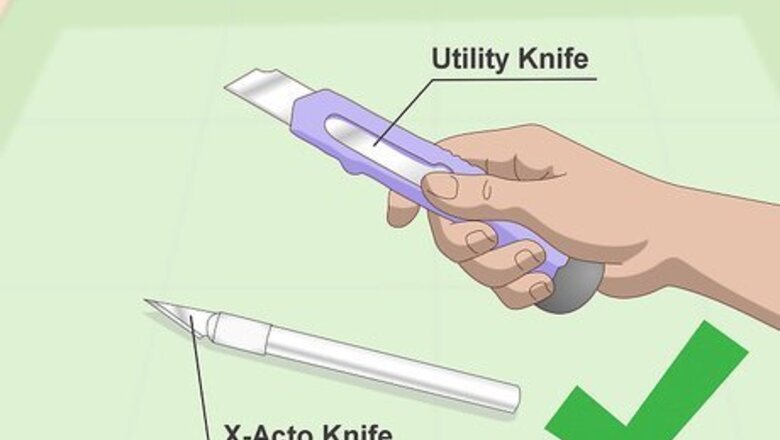
views
Making Clean Cuts

Start with a sharp knife. This will be the most important (and possibly the only) tool you’ll need to cut carpet. A standard utility knife is preferable, though something like an X-Acto knife or razor can also do the trick. Whatever you use, make sure the edge is nice and sharp. If you’re using a utility knife with a removable blade, take a minute to insert a new one before you get started. You might also use a handheld electric carpet cutting tool. These tools feature durable edges and automated cutting action, which can help you sidestep the difficulty of doing it manually.
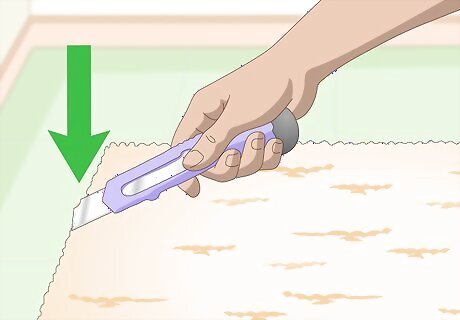
Place the tip of the knife against the carpet. Grip the knife in your dominant hand so that the angled edge of the blade is pointing away from you. Point the blade downward and touch the tip to your starting point on the carpet. Then, press down just enough to pierce the carpet’s tough backing. Cutting carpet is mostly a matter of getting through the backing, which is the hard, flat side that lays flush against the floor. Don’t jam the blade into the carpet too deeply. You might blunt or break your knife, or even mark up the underlying flooring.

Drag the blade along in a straight line. Once you’ve got the tip through the carpet, pull back on the knife using a slow, smooth motion. You should be able to feel the backing give way beneath the blade. Use a straightedge to guide your movements, and pause every two or three feet to reposition before you continue cutting. Keep your wrist fixed to avoid making sloppy or uneven cuts. If you don’t have the benefit of a straightedge, try feeling for one of the seams in the underside of the backing. Following a seam will help you make straight, steady cuts.
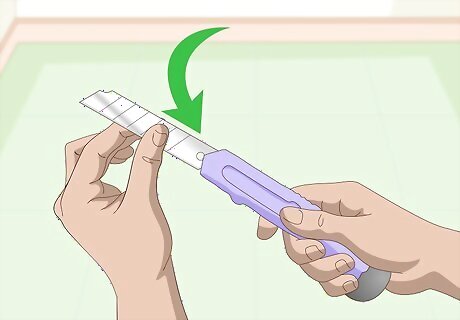
Replace your knife blade as needed. Your original blade will quickly lose its edge after slicing through multiple feet of tough backing material. To keep the project moving along, be sure to have a new blade on standby. Working with a dull blade will only slow you down. It may seem like a hassle to have to keep stopping to change blades, but it will save you considerable time and labor in the long run.
Cutting Carpet for Installation
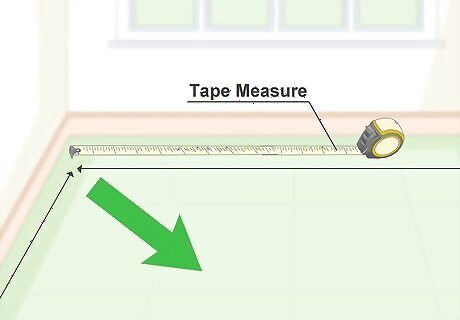
Measure your work area. Use a tape measure to find the length and width of the room you’re carpeting. This will give you an idea of exactly how much carpet you’ll need. It will also make it easier to cut each section to the proper specifications. Most rolls of carpet come in widths of 12 feet, so be sure to take this into account when plotting out the best way to cover the floor. To find the inner area of the room, multiply the length of the room (in feet) by the width.

Work a few feet at a time. The key to installing professional-looking carpet is to take your time and give each section the same amount of care and attention. Unroll the carpet as you go, separating it into more manageable strips. Cut two or three feet, then scoot back and resume cutting from a comfortable position. The roll itself can serve as a convenient reference for tracing straight lines.
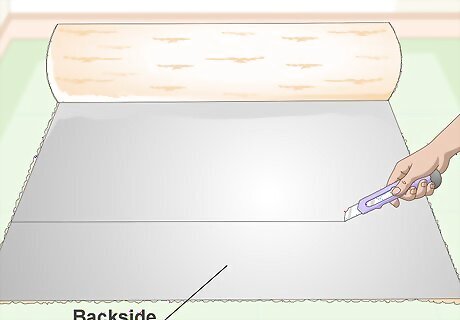
Make your cuts on the backside of the carpet. Whenever space allows, fold the carpet roll over and run your knife directly over the backing to achieve a cleaner cut with less struggle or guesswork. The backing is hard and flat, which means you won’t have to fight your way through the thick piling. Mark the backing with a pencil or permanent marker to indicate where you need to cut, or simply use the intersecting seams as a handy visual reference. Folding the carpet will also create a more secure cutting surface, preventing you from scarring the flooring underneath.
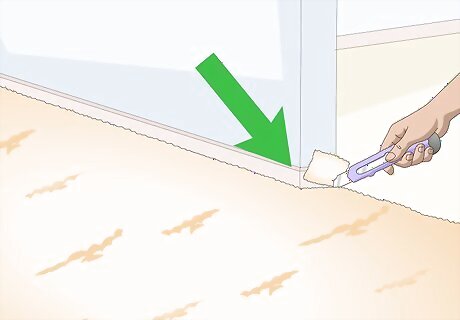
Cut carefully around corners, contours and openings. For some layouts, it may be necessary to leave space for a fireplace, a section of tile or some other piece of detailing. Measure these areas first so you’ll know how much carpet you need to trim. If you’re worried about making a mistake, you can lightly score the carpet on the first pass before committing to the cut. It may be helpful to perform a mockup of the cuts you intend to make on a scrap piece of cardboard first. Complex cutouts may be best left to the professionals.
Removing Old Carpet

Use the tip of the knife to open up a hole in the carpet. Begin with a section a few feet away from the wall. Make a slit approximately 4-5 inches long—it should be big enough to easily slip your hand into. Cutting the carpet every few feet will be useful for large or oddly-shaped rooms where you’re unable to remove it in one piece.
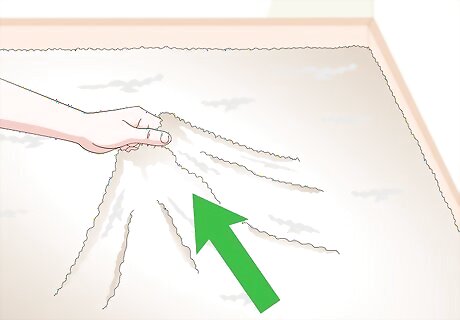
Pull up on the loose carpet with your free hand. Reach into the slit you just cut and lift the carpet away from the floor. You can now finish cutting without your knife ever coming into contact with the flooring. If your carpet is tacked down with staples or adhesive, it may take a little effort to get it started by hand. Use a putty knife to chip away at one edge until there’s enough to grab hold of.
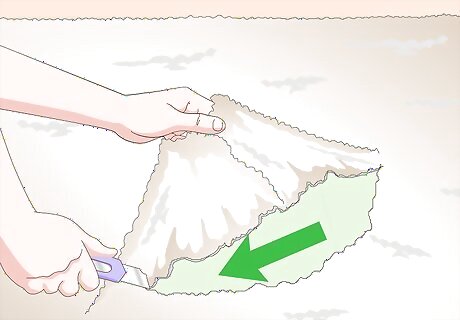
Continue cutting the carpet as you pull it up. The combined action of lifting and slashing should allow you to cut away large strips in very little time. After every few feet, move back and take a new grip on the loose edge. When you’ve cut all the way across a given section, peel it back, roll it up and set it aside somewhere out of the way. Since you’ll be throwing the old carpet out, there’s no need for precision or delicacy here. Don’t get into too big of a hurry—that’s how accidents happen.

Pry up the outer edge of the carpet. Pull the carpet free from walls and corners later using a claw hammer, pry bar or pair of pliers. That way, it won't snag on anything or provide resistance when it comes time to carry it away. Once you've gotten the edges started, go around the perimeter of the room and loosen the rest of the carpet by hand. If you're having trouble, use your utility knife to separate the carpet where it connects to the baseboards. Once the carpet has been cut and unfastened, you can simply roll it up, carry it out and dispose of it.
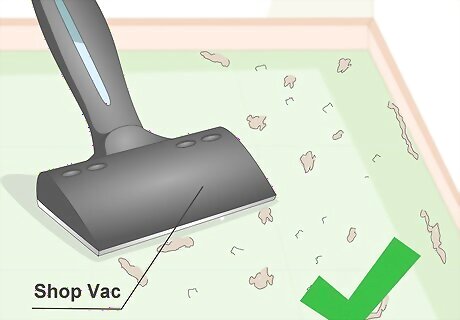
Dispose of any remaining materials. Before you call it a day, inspect the flooring beneath the carpet closely. Dig out any staples or dried clumps of adhesive you see with a floor scraper, then vacuum to clear the area of debris. After you’ve cleaned up, you can go on to install new carpet, hardwood, tile or laminate. Unless you’re planning on repurposing your old carpet, it can simply be thrown away once the project is complete. Dig out any remaining staples or dried clumps of adhesive with a floor scraper. A shop vac is the best way to collect dust, stray threads and other materials that are left lying around after removal.




















Comments
0 comment